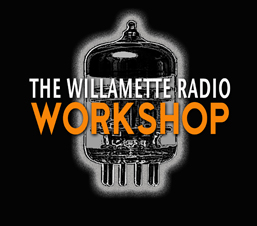Willamette Radio Workshop brings back “War of the Worlds”
BY PAUL DUCHENE Issue date: 10/26/2001
The Tribune
You might find it hard to believe as an adult that you were ever scared of things that go bump in the night.
But if there’s a little flicker in the back of your mind, you might enjoy Willamette Radio Workshop’s live re-creation of Orson Welles’ radio broadcast from Oct. 30, 1938, of “The War of the Worlds,” which takes over CoHo Theater on Saturday.
Welles’ Mercury Theatre managed to overamplify the story of Martians invading Earth by presenting it as a series of live news broadcasts. The resulting panic among listeners led to a front-page story in The New York Times and subsequent federal restrictions on radio broadcasts.
The very idea of radio terror seems far distant from the present, only a month after millions of viewers watched close to 5,000 people die on morning television when the towers of New York’s World Trade Center were destroyed.
But radio is theater of the mind, and the hobgoblins we create can be scarier than reality, however awful it is.
Portland actor Sam Mowry staged a reading of “The War of the Worlds” last Halloween with such success that he resolved to re-create Welles’ production.
“I did it last year with radio and TV people, and we were going to repeat it but it fell through because of conflicting schedules,” Mowry said. “Meanwhile I’d started Willamette Radio Workshop and everybody said: “Why don’t we do it?”
Twelve actors sound off Mowry aims to duplicate Welles’ hourlong CBS production with 12 actors and live Foley sound effects (named for Jack Foley, the technician who developed them).
Welles’ production, based on H.G. Wells’ 1898 book, was announced as a drama before it started, but the problems began when people switched to the 8 p.m. show in progress.
Starting with a news flash about explosions on the planet Mars, bulletins and scene broadcasts followed, describing a meteor hitting a farm at Grovers Mill, N.J. The meteor was then revealed as a metal cylinder from which strange creatures emerged firing death rays.
Meanwhile, large numbers of listeners had been listening to “The Chase and Sanborn Hour” with Edgar Bergen and dummy Charlie McCarthy on NBC, and many changed stations at the first musical break, rather than listen to Dorothy Lamour sing “Two Sleepy People.”
What they dialed into was Frank Readick as newscaster Carl Phillips describing the scene at the meteor as the Martians emerge. Police can be heard shouting in the background as Readick gradually loses his cool. Readick said later he based his delivery on the reporter who had witnessed the destruction of the Hindenburg only 18 months earlier.
Terrified voices can be heard as the din increases and the death ray guns are firing. Then abruptly, there’s dead silence. After Readick’s “death,” bulletins and news reports describe the Martian advance across New Jersey and nerve gas attacks on New York City.
(Those who listened to more of the show might have wondered exactly how the Martians managed to wipe out the 7,000-member-strong New Jersey National Guard and march clear across the East Coast in 15 minutes.)
Panic reigns At the break, the station announced that the show was a drama  but the damage had been done. Even though The Associated Press and New York and New Jersey police announced there was nothing to worry about, police stations and newspapers were swamped with calls, and panicked listeners rushed into the street. The New York Times alone received 875 calls.
Analyst Hadley Cantril estimated in a 1966 study that 20 percent of the audience exhibited signs of mass hysteria. Phone calls to friends and relatives spread the terror across the country, leading to scenes like the man in Pittsburgh who returned home to find his wife in the bathroom holding a bottle of poison and screaming, “I’d rather die this way.”
“The War of the Worlds” is seldom aired, though there is an original tape. Station WKBW in Buffalo, N.Y., successfully updated the play using its news staff and DJs and local settings in 1968.
“We won’t be broadcasting this one either,” Mowry said, recalling a 1950 broadcast in Caracas, Venezuela, that was so successful an angry mob stormed the station and burned it down.
Contact Paul Duchene at pduchene@portlandtribune.com.
“The War of the Worlds”
What: Live re-creation of Orson Welles’ broadcast
Where: CoHo Theater, 2257 N.W. Raleigh St.; 503-295-3565
When: 11 p.m. Saturday
Admission: $5

